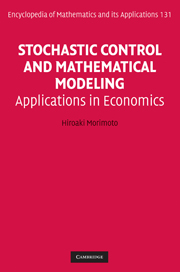Book contents
- Frontmatter
- Contents
- Preface
- Part I Stochastic Calculus and Optimal Control Theory
- Part II Applications to Mathematical Models in Economics
- 6 Production Planning and Inventory
- 7 Optimal Consumption/Investment Models
- 8 Optimal Exploitation of Renewable Resources
- 9 Optimal Consumption Models in Economic Growth
- 10 Optimal Pollution Control with Long-Run Average Criteria
- 11 Optimal Stopping Problems
- 12 Investment and Exit Decisions
- Part III Appendices
- Bibliography
- Index
11 - Optimal Stopping Problems
from Part II - Applications to Mathematical Models in Economics
Published online by Cambridge University Press: 07 September 2011
- Frontmatter
- Contents
- Preface
- Part I Stochastic Calculus and Optimal Control Theory
- Part II Applications to Mathematical Models in Economics
- 6 Production Planning and Inventory
- 7 Optimal Consumption/Investment Models
- 8 Optimal Exploitation of Renewable Resources
- 9 Optimal Consumption Models in Economic Growth
- 10 Optimal Pollution Control with Long-Run Average Criteria
- 11 Optimal Stopping Problems
- 12 Investment and Exit Decisions
- Part III Appendices
- Bibliography
- Index
Summary
In this chapter, we study the theory of optimal stopping problems in mathematical finance. We consider an investor, that is, an economic agent who can trade continuously in the stock market.
The stock price X(t) is governed by a stochastic differential equation with an expected return r. An American call or put option gives the right to buy or to sell the underlying asset with the reward function g(X(t)) at any time t. The objective of the investor is to decide the exercise time τ when he buys or sells the risky asset for the maximal expected reward E[e-rτg(X(τ))].
By the method of penalization, we solve the variational inequality associated with this problem. The value function coincides with its solution v and, by using v, the optimal stopping time is shown to exist.
The Model
Consider the optimal stopping problem for the stock price in mathematical finance. Define the following quantities:
X(t) = stock price at time t.
r = expected return of the stock, r > 0.
B(t) = the standard Brownian motion.
σ = the nonzero diffusion constant.
τ = exercise time or stopping time.
g(x) = reward function of stock x.
We assume that the stock price X = {X(t)} evolves according to the stochastic differential equation,
on a complete probability space (Ω,ℱ,P), carrying a standard Brownian motion {B(t)}, endowed with the natural filtration ℱt generated by σ(B(s), s ≤ t).
Information
- Type
- Chapter
- Information
- Stochastic Control and Mathematical ModelingApplications in Economics, pp. 252 - 268Publisher: Cambridge University PressPrint publication year: 2010
